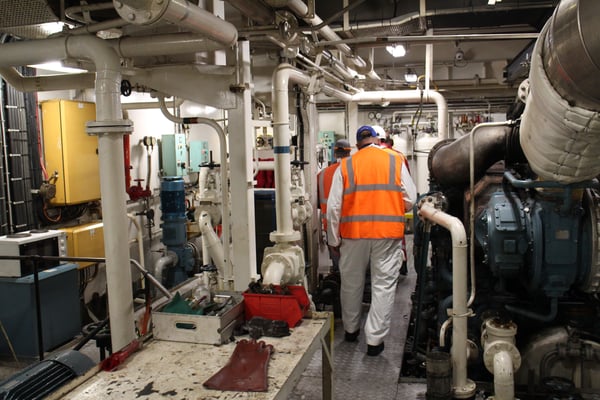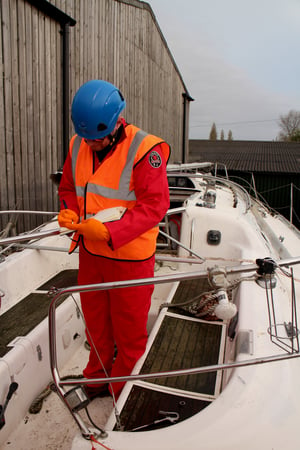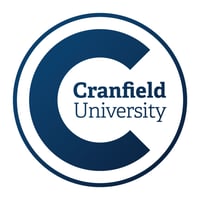
Last week, Bill Dawson, Senior Inspector (Ports & Harbours) for the Defence Safety Authority (DSA), wrote about the Applied Marine course (AMAI) that he recently completed at Cranfield – and how a good accident investigation is no accident. If you missed it, make sure you check it out before reading on.
- Enquire about the next Applied Marine Accident Investigation course (dates to be confirmed)
- Apply for the next Fundamentals of Accident Investigation course (14 Jan - 1 Feb 2019).
Part two of the blog is about week two onward – starting in Southampton – so, over to Bill!
Week two
Testament to the excellent relationships developed over many years, the Applied Marine Accident Invesitgation (AMAI) course is hosted by and embedded within the UK Marine Accident Investigation Branch (MAIB) offices in Spring Place, Southampton. It was a privilege to be lectured by the serving investigators, all bringing current experiences (and cases) to life, adding context to the theory. Here we had the chance to see the labs and analysis, talk to the experts, and see how reports were constructed from the myriad of collected information and data. MAIB now boasts their in-house developed analysis software (MADAS) and simulator, designed to make sense of the increasingly complex maritime domain. Perhaps most importantly, this gave an insight into the influence of digital developments and ‘big data’ on the business of accident investigation.

The highlight of the course though must be the simulation phase, for which two days at MAIB was the final preparation. This was where decades of investment in students, investigators and the maritime industry at large come together - with an astonishing array of commercial players willing to give up their time to enact a complex maritime accident - then provide a succession of witnesses primed to give their accounts to us fledgling interviewers!
Our scenario revolved around a ferry colliding with a yacht in the busy River Solent, with the added complexity of a transiting Very Large Container Ship (VLCS), Pilots and Vessel Traffic Services (VTS) (basically ATC for ships!) all thrown in. We were treated to a day at sea in the Solent to learn about the vessel in question, and presented with witnesses to interview ‘ad hoc’. ‘Media representatives’ were also in attendance, keen to press us for information that we either didn’t have, or shouldn’t give away. This was all filmed – to re-view for future learning and debrief – including a formal press conference staged at the hotel. We were also privileged enough to visit Southampton VTS and pilots, and their pilot/safety launch.

Day two of the simulation was wall-to-wall interviews. Masters, engineers, VTS, Harbour Authorities and bereaved relatives all came forward with challenging stories, with bewitching personality traits for us to navigate through to understand what happened. Cranfield cannot be commended highly enough for the work taken to put it all together. I’ll add my thanks here to those who gave of their time so willingly (on the off chance they read this!). At the end of a very full day, and crammed with multiple versions of the story (I wish I had taken better notes!), we relocated back to Cranfield to analyse our practical investigation.
It was probably around this time that the construct of the course started to make sense; not that it didn’t anyway (sorry Al!), but by now our guided progression from theory, to practice, to analysis and finally the production of a meaningful accident investigation report was clear.
Final Week
As we stepped into the final week, the first port of call was the accident lab at Cranfield – another world-leading facility where generously donated remains of accidents in air, rail and maritime are located to allow students to analyse post-accident effects in detail. The recovered hull of a yacht which had been holed and sunk in an accident was presented for us to analyse and add to the body of information for our investigation.
Back to report writing, and putting all the theory in to practice
Of course, one of the challenges was working in a team of eight independent, strong minded individuals with differing cultures and professional opinions! Whilst we all were in violent agreement with ‘what happened’ – agreeing the priorities of causal and contributory factors – and what should constitute a recommendation or a safety issue, was as much a challenge in leadership and diplomacy as accident investigation! But we got there (no blood was spilt!) and I have no doubt that we all benefited personally and professionally from the debate. The report was submitted and it was over to the course staff for a detailed critique…
Apart from a half-day of debrief on the reports (an important part of the learning process), that was about it for the formal part of the course.
We spent the last couple of days moving into a more philosophical look at the business of accident investigation: accountability, safety leadership, a fascinating session on fire forensics and ship stability/construction, and the increasingly pertinent aspects of psychology (stress, fatigue et al) in the marine community. These were all designed to add the final elements of context to the investigation – more ‘why it happened?’ than ‘what happened?’.
I’m sure by now you are firmly hooked and will be finding your way to the portal to register for the next course. But if you are not still fully convinced, it is worth stressing that it is not all work! There are also team-building evenings and course meals at a variety of locations woven into the course, all subtly building the personal relationships between delegates (and with staff), which is so essential for making the investigation simulation effective. But perhaps even more important were the professional network friendships made during the course which will, I have no doubt, endure.
Apply now!
So, if you didn’t realise it already, a good accident investigation is no accident! Almost certainly to get it right you will have been trained at Cranfield by the excellent staff and associates of the Cranfield Safety and Accident Investigation Centre (CSAIC).
If you really liked it, you can count the Fundamentals of Accident Investigation (FoAi) and Applied Marine Accident Investigation (AMAI) courses as Continuous Professional Development towards a Post Graduate Certificate in Safety and Accident Investigation (Marine Transport).
Good luck!
- Enquire about the next Applied Marine Accident Investigation course (dates to be confirmed)
- Apply for the next Fundamentals of Accident Investigation course (14 Jan - 1 Feb 2019).
Find out more
To find out more about what it might be like to study a Transport Systems course at Cranfield University, check out the video below.
